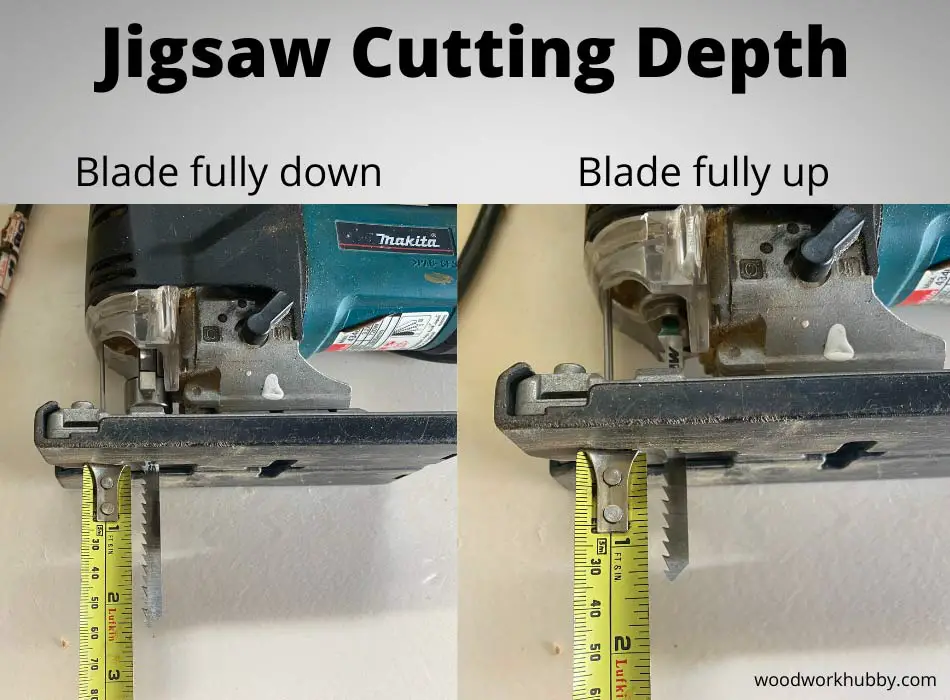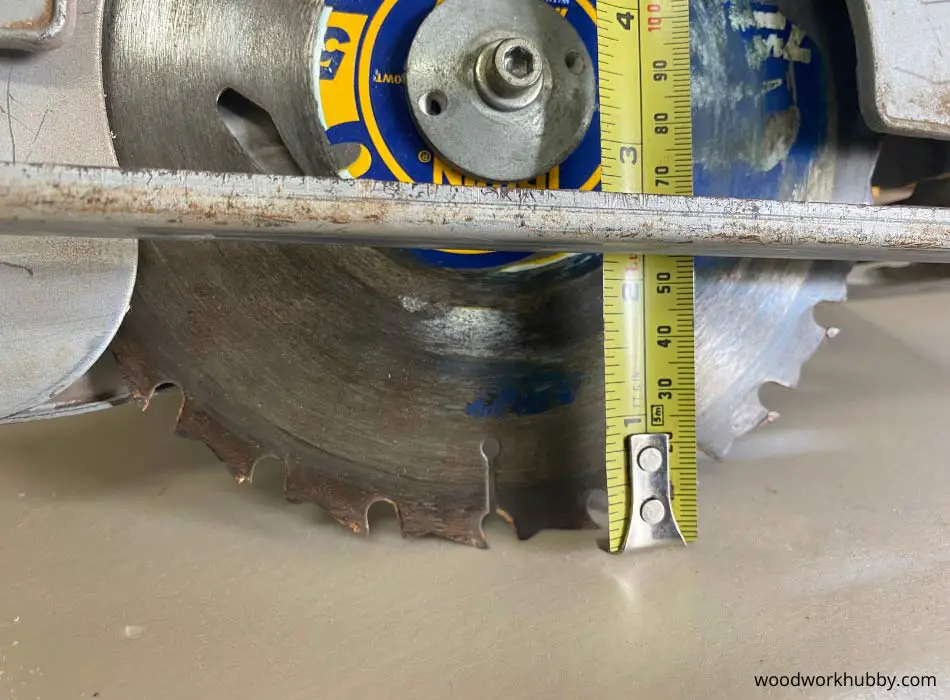Your jigsaw is one of your most reliable woodworking tools, so you use it a lot. You don’t want to burn it out though, which is why you wonder exactly how thick the wood is that a jigsaw can handle. For instance, can it cut through a 2×4? What about a 4×4?
Jigsaws can cut through 2x4s, but 4x4s are too thick for this type of saw. You’d instead need a miter saw with a 10-inch blade by 3.5 inches deep for slicing through a 4×4.
I have lots of great jigsaw information and tricks of the trade to share with you in this post. I’ll talk about how to cut a 2×4 with a jigsaw and what you should use when you need to slice through a 4×4.
Let’s get started!
How Thick Wood Can a Jigsaw Cut?
Jigsaws are used for making curved or straight cuts. The power tool features blades made of durable metals such as tungsten carbide or high-carbon steel.
Even still, just how suitable is a jigsaw for cutting thicker planks or blocks of wood?
The recommended cutting depth for a jigsaw is between 3/8 inches (10 mm) to 1 ½ inches (40 mm). A 2×4 piece of wood is approximately 1 ½ inches thick, so it’s just within the acceptable thickness range for a jigsaw.
Trying to cut wood that is too thick is the reason why your blade will bend. Check out my article on why does my jigsaw blade bend?

How Do You Rip a 2×4 with a Jigsaw?
Some woodworking projects call for ripping the wood. No, this doesn’t refer to tearing it to pieces, as that’s impossible to do with wood. Instead, ripping means cutting the wood lengthwise along its grain.
Ripping wood comes in handy for a variety of projects. You usually hear of ripping wood using a handsaw or a power tool such as a table saw, a band saw, a circular saw, or a radial arm saw. You’ve never tried ripping a 2×4 with a jigsaw, so how is it done?
Your jigsaw blade can fall out when cutting thick timber. Find out why here.
Here’s how to rip a 2×4 using a jigsaw:
- Pick a good blade
- Set the oscillation setting to high
- Guide the jigsaw through the cut
- Clean up the wood after cutting
Allow me to explain the process now in more detail.
Step 1: Choose the Right Blade for the Job
I talked about jigsaw blades a lot in a recent post, so that should have inspired you to go out and buy some higher-quality blades. That’s a good thing, as you don’t want to use just any blade when ripping a 2×4 with a jigsaw.
Instead, your blade should be designed for scrolling. Use a wider blade with medium-sized teeth and a heavier body. The blade’s teeth should be fresh, sharp, and ready for cutting.
Step 2: Set the oscillator
On the side of most good jigsaws, is a switch the controls the blade oscillation. This makes the blade come outwards as it cuts upwards rather than just straight up and down. The various settings have more of an effect on the blade with the number 3 setting being the strongest.
I always use the oscillation setting especially when ripping as you are cutting with the grain. This setting makes cutting with the grain much easier and quicker. See the below image that shows the switch.

Step 3: Begin Ripping
Guide your jigsaw by following your pencil line. Some jigsaws come with a fence you can attach to the base which makes ripping easier. I tend not to use them though as I find they restrict your control of the blade.
Step 4: Remove the Saw Marks
If you followed those steps as outlined, then you shouldn’t have many major saw marks. For any that made it through, you can use sandpaper or a block plane to sand them out.
The cool thing about ripping wood with a jigsaw is you can make a beveled rip cut as well. The only difference between doing that and following the steps above is setting your angle.
Jigsaws can cut 2x4s but not 4x4s
What Size Saw Do I Need to Cut a 2×4?
A 2×4, given its name, should have a width of four inches and a depth of two inches, right? Yet it doesn’t. Instead, a 2×4 is 1 ½ inches deep and 3 ½ inches wide.
The ideal saw for cutting a 2×4 is a circular saw with an 8-inch blade or a miter saw with a 10-inch blade. These saw blades are rigid resulting in straight and smooth cuts.
Keeping that in mind, what saw size is the most appropriate for a 2×4? Well, that depends on which angle you’re interested in cutting the 2×4.
For instance, if you have a saw with a blade that’s 5 3/8 inches and you wanted to slice through wood that’s an inch and a half deep, you’d have to cut it twice if you were approaching the 2×4 at a 45-degree angle.
Using the same saw though, you can achieve a 90-degree angle with just one cut.
What about a bigger blade size? If the capacity of the blade is over six inches, then you can slice through a 2×4 at a 45-degree angle after cutting once.
Even still, these blade diameters are considered on the smaller side, at least for some types of power tools such as circular saws. For those saws, the common blade diameter is 7 ¼ inches.
What Can You Cut a 2×4 With?
As I talked about earlier, a jigsaw is perfectly capable of cutting a 2×4, but maybe you lent your jigsaw to a friend or it’s out of commission. You’d rather not wait to cut your 2x4s, as you don’t want your woodworking project to be delayed for any longer than it has to be.
Besides, you have access to plenty of other saws in the meantime. Which saws are best for cutting a 2×4? Here’s a list of saws that can cut a 2×4:
- Jigsaws
- Circular saws
- Reciprocating saws
- Table saws
- Miter saws
- Handsaws
I highly recommend this jigsaw! It has always worked well for me.
I’ll now talk about each of the above types of saws (except for jigsaws, as I’ve been discussing them the whole time) you can use for cutting a 2×4 with details on how it’s done.
Circular Saw
As I touched on in the last section, circular saws are more than adept at slicing and dicing 2x4s. Between worm drive and inline or sidewinder circular saws, I would recommend the former for cutting planks of wood over the latter.
What exactly is a sidewinder saw? It’s a more traditional type of circular saw in which the blade and the motor share the same axis. The motor features a shaft that activates the blade. Many sidewinder saws are lightweight for easy handling, and they’re usually not that large either.
Make sure your blade is on the right way:
The opposite is a worm drive saw, in which the saw blade is at a right angle from the motor. The motor features gears that increase the torque. That torque then gets shifted to the circular saw’s blade.
For heavier-duty projects such as cutting burly pieces of wood, a worm drive circular saw would be a great choice. You don’t need quite that much cutting power when working with 2x4s though.
All circular saws are also good at cutting angles. Check out my article that explains how.

Reciprocating Saw
Sawzalls or reciprocating saws create a back-and-forth type of blade motion compared to spinning the blade as many power tools do.
Jigsaws are technically reciprocating saws, although those can also include rotary reciprocating saws, sabre saws, and scroll saws, so I’ll include them separately in this section.
Some types of reciprocating saws won’t make the cleanest cuts when slicing through or ripping a 2×4. It happens, and it usually isn’t the end of the world. Going back to what I said before, sandpaper or a block plane will be your best friends in smoothing and polishing the edges of each piece of wood.
Table Saw
Table saws feature a blade akin to a circular saw but they’re not freestanding as circular saws are. Instead, the aptly-named table saw is attached to an arbor. It still features a motor that uses gears, a belt, or electricity to move the components within.
On its own, I would not suggest a table saw for cutting 2x4s. When accompanied by a crosscut sled though, you can lessen kickback and enjoy smoother cuts.
Miter Saw
Speaking of crosscuts, that’s one job that miter saws excel at. If you need to slice exact angles into your 2×4 planks, grab a miter saw. You can achieve bevels, angles, and crosscuts easily, and you don’t even need a big saw for the job. A 10-incher should suffice. This is a great miter saw to buy. I love the bosch tools!
The reliability and precision of miter saws make them an awesome solution for any woodworking job in which you have to make similar cuts over and over. The uniformity of the result will enhance your project.
Japanese Pull Saw
How about some handsaws? Sure, you’re going to expend a lot more effort to cut a 2×4 with a handsaw than you would a power tool, but it’s doable, so I want to talk about it.
Japanese pull saws resemble a meat cleaver, so they’re certainly not the most common type of handsaw around. As you do a pull stroke, the saw cuts, hence the name pull saw. Although using a pull saw will make narrow cuts, they’re very clean. That’s not a guarantee you get out of all power tools.
Backsaw
Another type of handsaw at your disposal for cutting 2x4s is the backsaw. Back ribbing increases control and durability. The teeth on the saw’s blade are very close to one another, but this lends the saw clean cuts, especially when slicing into wood planks like 2x4s.
Can a Jigsaw Cut a 4×4?
If a 2×4 doesn’t measure two inches by four inches, then you can bet a 4×4 doesn’t have those precise dimensions either. And you’d be right, they don’t! A 4×4 is 3 ½ inches deep by 3 ½ inches wide.
While many types of handsaws and power saws can slice through 2x4s with aplomb, once you get into thicker 4×4 territory, that’s not always the case. Can jigsaws cut a 4×4?
Jigsaws cannot cut a 4×4, as their max cutting depth is 1 ½ inches. They just barely meet the requirements for cutting a 2×4. Using a long blade in a jigsaw will only lead to the blade bending and wandering in the cut.
What if you just tried to wing it and cut a 4×4 with your jigsaw anyway? Nothing good would result from that.
The blade of your jigsaw could get stuck in the wood. The jaw might begin jumping or bouncing, which makes it unpredictable and difficult to handle. See my article on 9 Reasons your jigsaw jumps and how to prevent it.
Your jigsaw will most definitely wander also as the blade at the top near the machine is mostly fixed but the bottom or end part of the blade usually bends and follows the grain of the wood.
I’m sure you can see where the risk of injury is a lot higher when you try to push your jigsaw to do something it’s physically incapable of.
Even if you don’t hurt yourself physically, you could break your jigsaw trying to cut a 4×4, and that’s going to hurt you emotionally (and financially!).
You’re much better off not risking it. If you have some 4x4s you need to cut, a 10-inch miter saw is a right tool for the job, not a jigsaw.
How Do You Cut a 4×4 Post in the Ground?
If you’re into fence-building, then you might someday face a scenario in which you have a 4×4 post in the ground that you need to cut. The size of the post is 3 ½ inches by 3 ½ inches just like a 4×4 plank of wood would be. How in the world do you go about cutting it?
A handheld circular saw with a 7 1/4-inch blade is adequate to cut a fence post off. Using a square, draw a line around the post and make at least 2 cuts, to cut right through the 4×4.
This type of cut is a little more difficult as you will be trying to hold the saw sideways while following your pencil line. This type of cut is also more dangerous due to the high risk of kickback.
Follow the below steps to cut a 4×4 post in the ground:
Square a Line Around Post
The first step is to use a square like this one and mark a square line around the perimeter of the post. You will need to do this as your saw will not cut right the way through in one pass.
Make sure the blade is square to the base
Use a square like this one to check that the blade is actually square to the saw base. This is important as when you do 2 cuts with a blade that is not square, the finished cut will be uneven.
Make 2 cuts
The first cut will be done from one side. Then go to the other side of the post and do another cut. The waste part should then fall off and your cut is complete!
While you can certainly cut fence posts off in the ground, more care should be taken to wear the correct safety equipment and be sure to have a firm hold of the saw.
This video will help guide you on how to do this.
Conclusion
Jigsaws are a handy power tool, but they cannot cut pieces of wood any thicker than a 2×4, which is 1 ½ inches by 3 ½ inches. At that size and thickness, a jigsaw can slice through or rip the wood.
Just don’t try cutting a 4×4 with a jigsaw, as it’s not going to happen. The wood is too thick for this type of saw!




